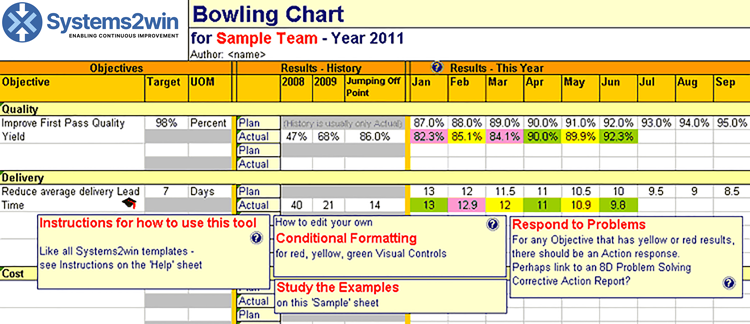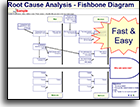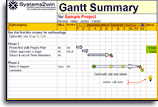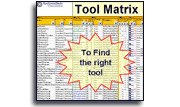Installation and Setup
Installation - Each User. Installation - Multi-user. Language Translations. Personalize Your Templates.Systems2win Training.
Quick Start Initial Training. New User Training. Training Matrix. Systems2win Leadership. Training Classes.Lean Training
Lean Training and Coaching. Lean Principles. Muda 8 Wastes. Goal - Lean Flow. Roadmap - Lean Journey. Value Stream Mapping. Standard Work. Hansei Lean Thinking. Lean Dictionary. Online Lean Training. Lean Leadership.Microsoft Office Training
Excel Training. Excel Drawings (without Visio). Excel Charts. Word Training. PDF Training. Document Storage and Naming.Support
Support.X-Matrix Hoshin Kanri template
Hoshin Planning Xmatrix Excel template for Hoshin Kanri Strategy Deployment
X Matrix template for Policy Deployment
Why use your Hoshin Kanri template

To develop & implement strategic plans and unique competitive advantages benefiting from input & ownership from all levels of the organization in a way that greatly accelerates organizational learning and leadership development.
The Japanese characters for Hoshin translate as 'shining needle', 'direction', or 'compass', and Kanri means 'management', but Hoshin Kanri is most often translated as 'policy deployment' or 'strategic deployment'.
Hoshin Kanri is an organizational learning method
to deploy the PDCA scientific method systematically and relentlessly designing and testing nested experiments, deep through the tissues and layers of your entire organization.
It is a systematic way to develop and continuously improve your unique competitive advantages
For the first time, people really 'get it'
In the past, your strategic planning process may have been mostly an 'ivory tower' academic exercise where once a year all the executives get away to huddle together to dust off the Strategic Plan that no one has looked at in 11 months, and come up with some new grand plans that no one will be able to remember a month from now.
With your X Matrix template, people at all levels of your organization truly understand (and are motivated by) how their team's To Do List fits in with your company's over arching strategic objectives.

Sample X matrix example
Note: Your company might have a different label for 'Action Programs'.
Maybe 'Strategic Projects', or 'Strategic Initiatives', or whatever.
How to do Hoshin Planning
First — take a few minutes to get oriented
Before you get started, we suggest that you take a few minutes to digest two concepts that are foundational to the Hoshin Kanri approach to strategic planning:
- Nested Experiments
- Catchball
Nested Experiments
| Teams | Nested Experiments |
|---|---|
Hoshin Team Usually the management team in charge of the business unit (the business unit might be a company, division, product line, location, department, or value stream)
Might also include high-level representatives of other stakeholders, such as parent or sibling organizations, suppliers, customers, unions, etc.
The Hoshin Team Leader is either the leader of the business unit, or at least someone who reports directly. |
Long-term Strategic Intent Define your Mission, Vision, SWOT Analysis, competitive positioning, core competencies, in a flexible long-term Strategic Plan that ideally features a Big Hairy Audacious Goal. Scan the environment to define the most important challenges for strategy to address — using financial projections, Value Stream Maps, and Lean Assessments, and other strategic planning tools. |
Mid-term Strategic Initiatives (3-5 yrs) Identify, analyze, and prioritize no more than 5 breakthrough Objectives to eliminate gaps between vision and current capabilities. Create intermediate state value stream maps. Create the Hoshin Team Charter. Populate the Mid-Term X Matrix Measures & Targets, and Action Programs — and the bottom 2 correlation sections. (leaving Action Items and Responsibilities blank) Preserve ideas for lower-priority |
|
Annual Hoshin Do everything you did for the mid-term Hoshin, but this time narrowing your focus to Objectives that can be accomplished in 6–18 months. Complete the entire Annual Hoshin X Matrix (including Hoshin Team Action Items, and the Responsibilities sections, and all 5 correlation sections). For each Action Item on the Annual Hoshin X Matrix, create a proposed Team Charter, and assign members of the Hoshin Team to be full or part-time members of the Tactical Teams. Each Tactical Team must be led by a Hoshin Team member. |
|
Tactical Teams (optional) You can have any number of intermediate layers of teams — and you can call them anything you want Chartered by the Hoshin Team |
Tactics to develop competitive capabilities specified by the Each team goes through a round of catchball to involve all managers to improve the Annual Hoshin and negotiate the terms of agreed-upon Tactical Team Charters. |
Operational Teams (optional) Chartered by the Tactical Teams |
Operations 3-6 month projects — defined by the Annual Hoshin and the Tactical X Matrices Each team goes through a round of catchball to involve all supervisors and team leaders to improve the higher-level X Matrix and negotiate the terms of agreed-upon Operational Team Project Charters. |
Action Teams Chartered by any of the above teams to implement specific improvement events and daily continuous improvement. If your team isn't involved in the creation and deployment of an X-Matrix, then your team is an Action Team. An Action Team simply means "next step is implementation; no more planning". |
Kaikaku and Kaizen Events Clearly defined projects that can be completed in 1-12 weeks to apply new tools and methods to daily standard work. Can be any mix of A3 Projects, 8D Corrective Actions or any other types of projects. |
Daily Kaizen Daily habits and systems for problem solving, idea generation/implementation, and the continuous improvement of daily standard work. This is where you will use most of your lean tools, and templates for your lean management system. |
Catchball
The most essential difference between hoshin strategic planning and traditional strategic planning is catchball.
Your hoshin team designs your catchball process to fit your organizational structure.
- Small organizations with few hierarchical layers will play few rounds of catchball, while larger organizations might play a round of catchball between each of the optional Tactical and Operational phases.
- Organizations new to Hoshin Kanri might start out with only 1 round of catchball with mid-level managers, while mature lean organizations might involve every single employee in some level of hoshin planning.
- Advanced organizations might add additional rounds of catchball to seek the insights of their board of directors, customers, suppliers, or other stakeholders.
How to use your
Hoshin Kanri template (continued)
If you are the (top-level) Hoshin Team
Step 1) Complete your plans for the first 3 Nested Experiments
Follow the instructions in the Nested Experiments table (above) to complete your plans for the first 3 Nested Experiments:
- Long-term Strategic Intent (5+ year horizon)
- Mid-term Strategic Initiatives (3-5 year horizon)
- Annual Hoshin X-Matrix, and proposed Team Charters for each Action Item on the Annual Hoshin

Step 2) Play Catchball
Be prepared to truly listen to the ideas and concerns that trickle up from the other layers of Hoshin Planning — perhaps revising the top-level Annual Hoshin based on feedback.
If your team is creating a lower-level Hoshin Plan
Tactical or Operational
Step 1) Play Catchball
Follow the online instructions for how to prepare for and conduct a round of catchball.
Step 2) Finish completing your Team's X Matrix
- Transcribe Objectives from the Annual Hoshin
(see tips on the Sample sheet of your Systems2win Xmatrix template)
- Use Value Stream Mapping and your Lean Management System to identify, analyze, and prioritize breakthrough Strategic Challenges.
- Create a proposed Team Charter and perhaps more detailed project plans for each Action Item that your team commits to accomplish.
- Establish Measures & Targets for your team's contributions.
- Transcribe Action Programs from the Annual Hoshin — editing & adding as per the tips on the Sample worksheet
- Define Correlations. There is a strong urge to skip this step, but it is foundational to one of the primary purposes & benefits of Hoshin Planning — understanding (and testing) cause and effect relationships.
-
Do not skip this. Perhaps use Cell Comments to record dissenting opinions.
The conversation is more important than the result. - Assign part-time and full team members and a leader for each Team Charter / Action Item.
Step 3) Present each proposed Team Charter to the next-higher hoshin team
Expect about 20 minutes per Team Charter plus extra time if proposing significant new resource requests
Step 4) Revise the next-higher X Matrix and this team's project plans
Expect a half hour discussion of the relationships between the proposed team plans and the next-higher hoshin plan, and another quarter hour to document agreed-upon changes.
Step 5) Publish your results
It is common to publish both printed and electronic forms of the same document:
- Use a plotter to publish a large printed version—somewhere very visible to everyone in your Department or Team. And replace it often enough to keep it fresh.
- Publish the electronic version on a server where all of your team members can share it and follow links to related documents.
User-Defined Training
You can optionally use the 'User-Defined Training' section at the bottom of the Help sheet of any Systems2win template — to supplement Systems2win's (already excellent) online training with your own supplemental training.
Maybe link to that PowerPoint or video that you paid your consultant to develop for you?
And your User-Defined Training will be automatically found and transferred to the new version of your templates every time that you upgrade over the years — along with many other common personalizations that you might make to your master templates.
How to use your
X Matrix Hoshin Kanri Template
aka Policy Deployment Matrix, Hoshin Plan template, or X matrix template
Policy Deployment Spiral
When we originally released this policy deployment template, we called it a 'spiral', because...
you start with your strategic breakthrough 'Objectives' and 'Measures & Targets'

which can either be dynamically linked or simply copied from your team's Balanced Scorecard
and then you spiral your way around to the 'Action Programs'
the implementation of which often require cross-departmental coordination
and finally spiral to the 'Action Items' at the top of the xmatrix
which serves as a high-level shared To Do List for your work team
Before getting started
Your leaders might personalize your master template.
Find and open your template
Find and open your X Matrix template
(X-Matrix.xlsx)
in the same way that you find and open your other 150+ Systems2win templates.

Save your working document
following the usual document storage and naming conventions established by your leaders
Open a Blank Sheet
When you're ready to start doing your own real work...
click the button to 'Open a Blank Sheet'
Excel Ribbon bar > Systems2win tab > Open a Blank Sheet
This blank sheet is where you will do your real work
(not on the Sample sheet — which gives you sample data that is extremely helpful for learning how to use your new tool, but is the wrong place to do your real work)

Rename your new sheet.
If English is not your preferred language
Switch to your language, just like every Systems2win Excel template.
Distribute to unlimited users
1) Using the button to 'Generate a Working Document'
Simply click the button to 'Generate a Working Document to generate a fully functional X-Matrix Excel template

that can be used in ANY version of Excel,
(including Macintosh and tablets)
even by users that do not own a license for Systems2win
See full details of License Agreement
2) Using PDF
Another way to make ANY of your 150+ Systems2win templates available to unlimited users that don't own Systems2win is to distribute in PDF format.
Your PDF's can even include active hyperlinks that your users can click to open related documents.
Now your team is ready to start using your
X-Matrix template for Hoshin Planning
Perform Hoshin Kanri and Catchball
Your team(s) will then perform Hoshin Planning — following the instructions in the next section.
Working closely with other planning teams (above and below your team's level on the organization chart), each work team actively participates in the creation (and ownership) of their own x-matrix.
Each team publishes their Hoshin Plan (and other related documents) where every team member can find them often printed on large plotter paper, and taped onto a highly visible bulletin board, as well as also allowing people to download the electronic version from a server which is updated more often, and is where team members can follow hyperlinks to related documents.
Refer to the Help and Sample sheets of your X Matrix template for additional helpful guidance.
If policy deployment has never been a strong competitive advantage in your company, then this Hoshin Planning tool can take your strategic planning (and especially implementation) to previously unimaginable levels.
Use Hoshin Kanri to manage just about anything
Although the Policy Deployment Matrix is most commonly used as a way to manage strategic change initiatives, once your people get the knack, it also proves to be a powerful tool to manage just about any type of change:
- Improve your value streams
- Integrate your supply chain
- Manage a portfolio of related brands, products, or value streams
- Launch a new product or service
- Manage lean six sigma projects and strategic change initiatives
- Manage any complex project that involves cross-functional cooperation
Although the Bowling Chart template was originally introduced for hoshin deployment, it is also an excellent tool for managing any type of time-phased project.

More templates for Hoshin Kanri
As part of the actual hoshin planning process itself...
your teams will use mostly the X-Matrix template, the Team Charter templates, the Team Roles template (to define YOUR Hoshin Team structure and responsibilities), the Balanced Scorecard, the Bowling Chart, and various Project Management templates.
But at some point, you're going to expect your teams to actually accomplish their strategic objectives, right?
Not just plan them... but actually accomplish them.
And everyone in every hoshin team at every level of your organization is going to have different needs for different types of lean tools and methods to make it easier for them to accomplish their unique inter-related assignments.
At that point... wouldn't it be nice if your leadership provided a well-organized toolkit with dozens of the most popular lean tools that different team members might find useful?
All professionally developed, with consistent standardized ways of doing things, so that when a person learns how to use any one tool — he or she knows how to use all 150 other similar tools.
Wouldn't that be nice?
Welcome to Systems2win.
Here are some...
Popular process improvement tools and methods
that different members of your hoshin teams might find useful in different phases of your policy deployment cycles:
- Lean Assessment
- Process Analysis
- Results Measurement
- Leader Standard Work
- SQDC Huddle Board
- Value Stream Mapping
- Supply Chain Mapping
- Flow Charts
- Product Family Matrix
- Problem Solving Tools
- Root Cause Analysis
- Thought Map Relations Diagram
- Brainstorming
- Force Field Analysis
- Decision Making Tools
- Decision Matrix
- Potential Future Improvements Idea Bank
- Training Matrix
- Any of the tools for training people
- A3 Report or 8D Report for problem solving
- Approvals form
- Gemba Interview
- Process Observation worksheets
- Voice of the Customer Kano Analysis
- Quality Functional Deployment
- Critical To Quality Tree Diagram
- DMAIC Measurement Selection Matrix
- Pareto Chart
- Histogram
- Scatter Plot
- FMEA and Control Plan
- SMED Quick Change Over
- Heijunka load leveling tools
- OEE Overall Equipment Effectiveness
- Balanced Scorecard
- Organization Chart
- All of the strategic planning tools
- Gantt Summary Milestone Chart
- Gantt Chart
- Bowling Chart
- Team To Do List
- Team Facilities Checklist
- Meeting Agenda & Minutes template
- Ground Rules for Working Together template
- Change Management
- Any of the project management tools
- All of the kaizen event planning tools
- Lean Training PowerPoint
- Lean Training web section









Why not try them?
Suggested Reading and Resources for
Hoshin Kanri Policy Deployment
- Hoshin Kanri for the Lean Enterprise, by Thomas Jackson
- The Basics of Hoshin Kanri, by Randy Kesterson
- Balanced Scorecard, by Robert Kaplan and David Norton
"There is nothing so useless as doing efficiently that which should not be done at all."
~ Peter F. Drucker
This X Matrix Hoshin template comes with
ALL of the other Strategic Planning tools
AND the Project Management tools
AND the Kaizen tools
AND the Lean Management tools
AND the Value Stream Mapping tools

Contents
Policy Deployment Benefits
Teachable, repeatable system with huge return on investment
Confirm practicality of proposed plans (and probability of success)
Wide-spread understanding
of what needs to be done, why, and how
Feedback & Ideas
are systematically solicited, listened to,
and often acted upon
Ownership & Buy-In
is a lot higher when the people responsible
are actively involved
in the planning
People 'get it'—
they finally can see how their team's To Do List fits in with your company's Strategic Objectives
Training and Coaching
Consider Training and Coaching to support your teams to succeed

Training to get you started.
Tools you won't outgrow.
Schedule a Conference
Schedule a conference
to discuss your challenges
with an experienced lean advisor
New User Training
Your Systems2win templates come with free New User Training
to quickly learn features that are common to all 150+ templates
Questions?
One huge benefit of owning your Systems2win templates is Support when you need it
Download Trial Now
Get a dozen trial templates,
and another dozen free gifts
@@@ Better conversion rate
if call to action is for a specific tool, and shows the image

Try It
Try this template
along with a couple dozen more
process improvement tools
Calls to Action Botttom
Related Topics
Related Topics section WITHOUT TESTIMONIALS
Replace this paragraph with menu library item for topics related to this video
Training and Coaching
Consider Training and Coaching to support your teams to succeed

Training to get you started.
Tools you won't outgrow.
Schedule a Conference
Schedule a conference
to discuss your challenges
with an experienced lean advisor




























